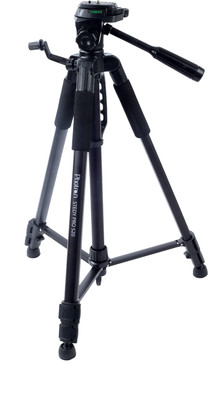A tripod is simple, portable three-legged frame, used as means for supporting the weight and maintaining the stability of the object. The three legs are positioned away from the vertical centre allowing the tripod more resistance to lateral forces and also stability against downward and horizontal forces and movements about horizontal axes. In photography, it is used to balance and raise a camera, a flash unit or other photographic equipment. Photographic tripods have mounting heads to attach a camera. The mounting head usually includes a thumbscrew that can be connected to the baseplate of the camera, and also mechanisms to rotate, tilt and pan the camera when it is mounted on the tripod. In order to save space and easy to carry around, the tripod legs are made to be telescopic and are usually made of light materials such as aluminium, carbon fibre, steel or plastic.

Still and motion photography make use of tripod. Mainly to prevent camera movement, they are also necessary when lenses of extreme focal lengths are used or a slow-speed exposure is being made, as even the slightest camera movement while the shutter is open will produce a blurred image. Since stability is achieved, camera shake is also reduced thus giving maximum sharpness. It is also helpful in precise framing of the subject. It’s often required for professional photography.
Selecting the right tripod for your camera can be quite tricky. There are few tips that you could keep in mind when choosing one. They are:
Weight – The weight of the tripod should be looked from two angles. Firstly, you are the one who will need to carry it around. If you’re travelling or will carry it around a lot, go for a lighter option. Secondly the weight of the equipment you’re going to put on it. Small cameras do not require a heavy tripod while acanon dslr with large lenses may require a heavy tripod to handle the weight.
Stability – Heavy tripods don’t always need to be equally stable. Try it out against conditions like windy rocky surfaces.
Leg locks – The locking mechanism varies from tripod to tripod. Look for ones that are easy to use and will be strong and hold the legs in place with the full weight of the camera.
Leg sections – Since tripods use telescoping mechanism, it’s always best to look for one that offer three or more sections. More sections means smaller fold up and a sturdier construction.
Height – It depends on the style of photography. Think of the maximum and minimum height required so that you don’t need to bend all the time while framing a shot. Also look at the portability factor.
Tripod Heads – They come in two types – ball and socket and pan and tilt. Ball and socket are flexible and allow easy movement of the camera, its smooth and user friendly. Pan and tilt lock the camera into position, given a more camera shake free framing.
Weight – The weight of the tripod should be looked from two angles. Firstly, you are the one who will need to carry it around. If you’re travelling or will carry it around a lot, go for a lighter option. Secondly the weight of the equipment you’re going to put on it. Small cameras do not require a heavy tripod while acanon dslr with large lenses may require a heavy tripod to handle the weight.
Stability – Heavy tripods don’t always need to be equally stable. Try it out against conditions like windy rocky surfaces.
Leg locks – The locking mechanism varies from tripod to tripod. Look for ones that are easy to use and will be strong and hold the legs in place with the full weight of the camera.
Leg sections – Since tripods use telescoping mechanism, it’s always best to look for one that offer three or more sections. More sections means smaller fold up and a sturdier construction.
Height – It depends on the style of photography. Think of the maximum and minimum height required so that you don’t need to bend all the time while framing a shot. Also look at the portability factor.
Tripod Heads – They come in two types – ball and socket and pan and tilt. Ball and socket are flexible and allow easy movement of the camera, its smooth and user friendly. Pan and tilt lock the camera into position, given a more camera shake free framing.
Some of the companies that manufacture tripods are Manfrotto, Fotopro, Simpex, Vanguard and many more. Some of the models come with remote controls to control a camera without having the need to operate the camera manually.
No comments:
Post a Comment